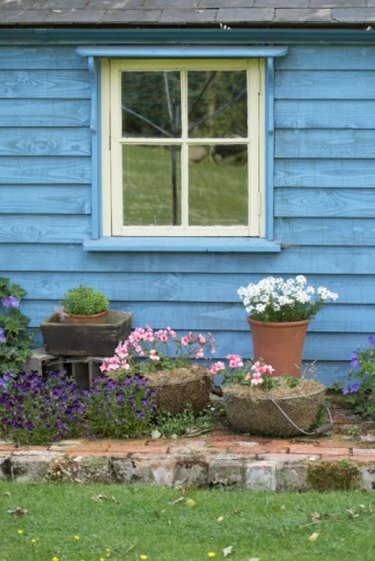
Exterior window screens, glass or vinyl panes, frames, sashes, sills and trim can often take a beating from hail and the elements. Exterior and interior window trim comes in many materials: wood, aluminum, steel or vinyl. Hail damaged window trim may show gouges, spatter marks, cracks and indentations. Depending on the extent of the hail damage, there are different approaches to repairing exterior window trim.
Observation
Video of the Day
Exterior window trim exhibiting lesser degrees of hail damage may have uneven pinging, or indentations. These shallow dents may not be visible from a distance and sometimes are only detected by touch. Vinyl, steel and aluminum window trim damage may only exhibit paint chipping without hail penetration. If the damage isn't to the extent that it bothers the homeowner aesthetically, no action is required. Periodic window trim inspection should be performed, especially after new storms or extreme weather change, to ensure no further damage is occurring due to the original hail damage.
Video of the Day
Repainting
Mild hail damage to wood and aluminum window trim can be painted over without any further preparation. Use exterior oil-based paint for wood and paint intended for application to exterior metal surfaces for steel and aluminum window trim. The coating of the paint may fill in shallow indentations without any additional work. Vinyl window trim is difficult to paint over as paint may not adhere permanently to the vinyl. Priming the vinyl trim and then painting it may make the coat of paint last longer, but ultimately paint chips away from vinyl.
Sanding, Filling and Repainting
Mild to moderate hail damage to wood trim may be fixed by resurfacing. Sand the indentations and gouges out of the window trim using medium and then fine-grit sandpaper until no rough edges are left around the damaged areas. Vacuum the sanding residue, and wash the window trim with water and liquid dish detergent. Dry the window trim with towels, or allow the trim to air dry. Fill the indentations to overflowing with spackling compound intended for exterior use. Use a damp rag to smooth the spackling level with the window trim surface, and allow the spackling to dry. Sand the repaired areas smooth and level with the window trim. Paint a wood surface primer over the trim, and allow it to thoroughly dry. Paint the wood trim with an oil-based exterior paint. Owners of homes predating 1979 should not sand paint without first testing for the presence of lead. Most homes predating 1979 were painted with lead-based paint, and sanding the wood poses an inhalation and ingestion danger. Your local health department can advise you on how to proceed with repairing painted wood, steel or aluminum trim on older homes.
Total Replacement
Extensive hail damage may crack or shatter exterior window trim to the point that repair is unlikely. In these cases, total replacement of the trim is necessary. Wood trim can sometimes be patched and repaired, but steel, aluminum and vinyl trim are more difficult to fix. Often vinyl trim is one piece rather than multiple sections, which necessitates total replacement. If you don't have the skills to replace exterior window trim and don't have the time or inclination to learn the process involved, professional services and home improvement stores offer repair services. Costs often include materials and labor.
- Family Handyman: How to Prepare Wood Trim for a Smooth Paint Job
- International Association of Certified Home Inspectors; Mastering Roof Inspections: Hail Damage, Part 10; Nick Gromicko, et al.
- Grand Window and Repair: Exterior Wooden Window Terminology Diagram
- Hammer Zone: Exterior Trim & Siding Projects
- “This Old House” Magazine; How to Install Window Trim; Tom Silva
- PlyGem Vinyl Windows: Vinyl Replacement Window Accessories